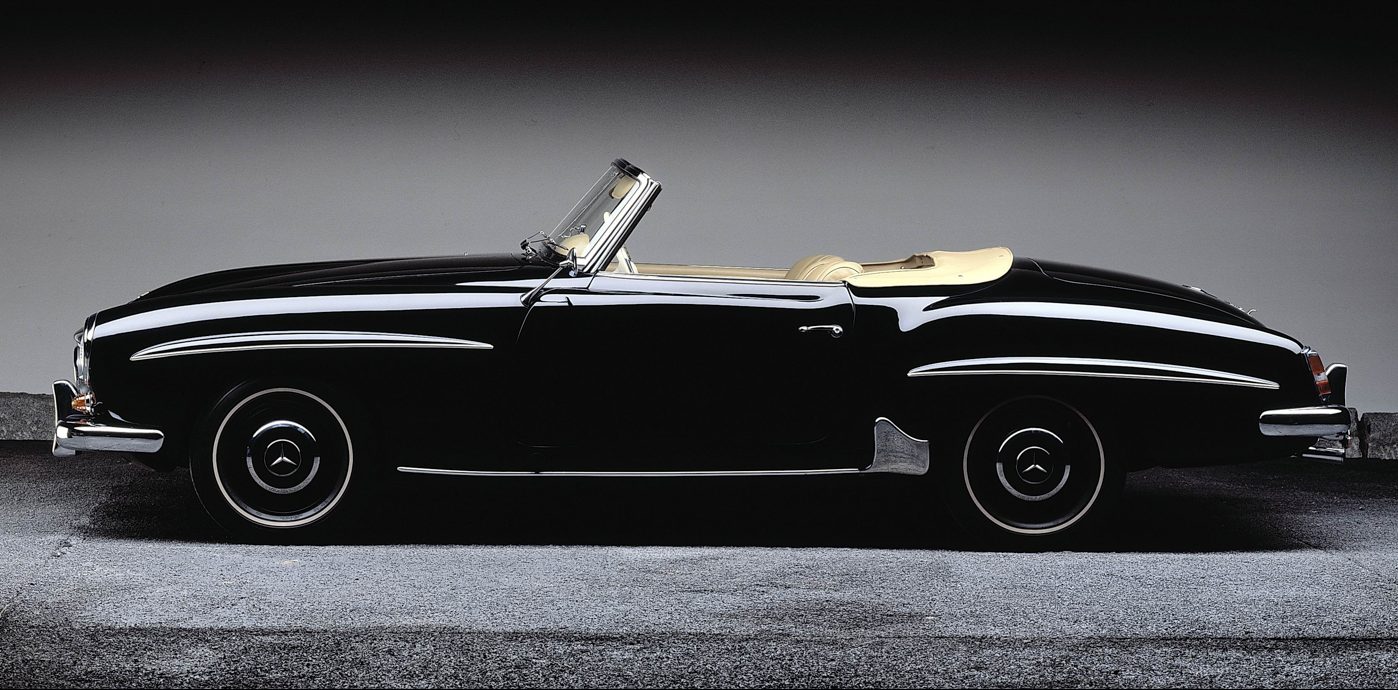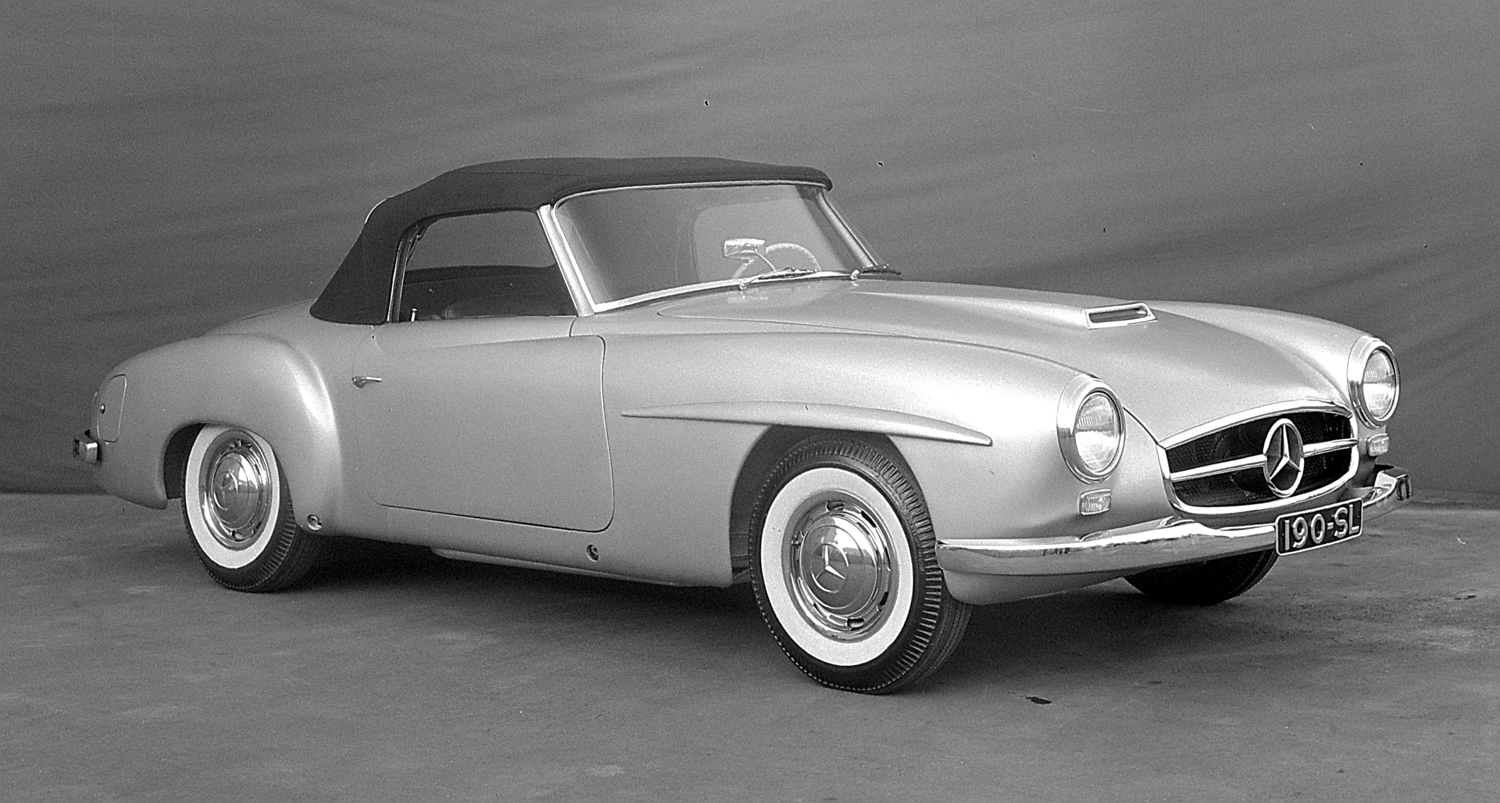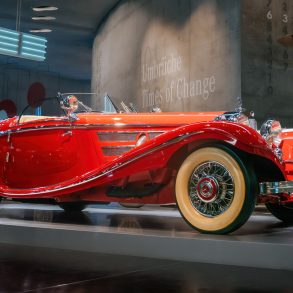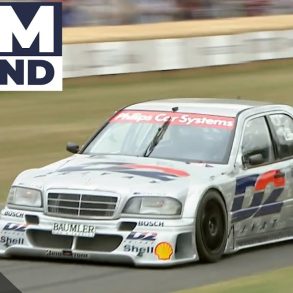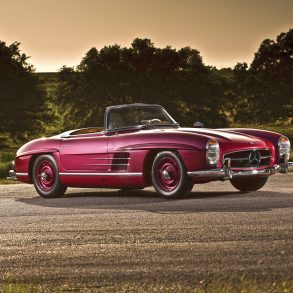By the 1950s it was clear that Americans were in the mood for sporty cars with the right balance of style and performance. For many young people, single, married, or even with small children, a small two-seater presented a delightful relief from the lunking, heavy American cars that still seemed stuck in the 1940s. Among the many European car companies that were paying close attention to this growing market, Mercedes-Benz was poised with an offering that not only would captivate the hearts of Americans, but would also set a new world standard for sporting fun in an open two-seater car with plenty of style and performance to match.

Introduced at the 1954 New York Auto Show, the prototype 190SL was cleverly situated alongside the powerful and prestigious 300SL Gullwing. With such celebrated company the 190SL immediately struck a glamorous chord with all onlookers. Displaying all the characteristic quality, fit, and finish of the 300SL, the 190SL delivered in every respect. The motoring press showered the new 190SL with ample praise confirming this affordable convertible would surely lead the way to new markets in North America.

Principally motivated by U.S. distributor and marketing pioneer of European imports, Max Hoffman, the 190SL positioned Mercedes-Benz as a premier brand in the growing North American market. Strategically priced at around $4,000, the 190SL was almost half the price of the 300SL. This attractive value, coupled with irresistible looks and open cockpit driving, motivated nearly 26,000 buyers to purchase these sporting cars between 1955 and 1963. And while these numbers might seem modest in terms of modern car sales today, during this period, these important sales catapulted Mercedes-Benz into a larger market opportunity, one that would greatly advance their broader objectives far beyond the more costly and lower volume 300SL. Shortly after the first year of production, the public fell in love with the 190SL not just because of the fantastic looks and quality, the 1900-cc SOHC engine with twin Solex carburetors coupled to the 4-speed transmission, delivered spirited driving while returning admirable fuel economy.

Driving manners were also rewarding via double-wishbone coil spring front suspension and swing axle coil spring rear suspension. Attributed to the Mercedes-Benz engineer Rudolf Uhlenhaut, the term SL is generally regarded to mean Sport Light or Super Light, characterizing the nimble nature of these cars but also the sporting heritage that Uhlenhaut had so carefully crafted as part of the racing dominance Mercedes-Benz achieved as formidable motorsports competitors against Ferrari, Jaguar, and Aston Martin. Today, the 190SL remains an attractive and highly desirable classic very much for the same reasons experienced upon its launch; a comfortable sporty car blending elegant open motoring with easy to service mechanicals. Despite the 190SL being the modest lower priced sibling of the 300SL, over the past 60 years it has charmed its way into more celebrated collections in part because of its heritage to the 300SL.
Striking in every view, the 190SL immediately brings to mind the cavalier mid to late 1950s so fervently romanticized in movies, theater, and music of the period. Offered with a removable hardtop and custom-tailored luggage, the 190SL was more than transportation, it was a statement of carefree elegance without the opulence of stone mansions and tuxedoed butlers.
The 190SL offered a wispy interlude that modestly displayed a new form of personal wealth, one of motoring adventures, overnight motel stays, Palm Springs or Atlantic City getaways, and bright colored clothing with tousled hair. With the emergence of this upper middle class of urban professionals, the 190SL was the perfectly balanced partner, even for a young family. The convenient rear storage shelf served as ample space for small children that could comfortably sit sideways behind mom and dad long before seatbelts became common for occupants of any size.

Comparing the side view of the 190SL to the later offered 300SL Roadster, it’s clear that the 300SL gullwing genetics permeated the line with clarity and conviction. Though no exterior parts of significance are interchangeable between the 190 or 300, the 190SL carries the same sensuous fender undulations and distinct front and rear fender speed lines, which taper out over the wheels, sharply trimming the tops of the tires, visually lowering the profile of the entire car. Although the 300SL has a lower stance and more race-profile body dimensions, the front view, grille, bumper contour, and hood line are so similar that a quick glance of the front view of both cars, makes it difficult to distinguish one from the other.

It’s all the more remarkable considering that today a very fine 190SL will set you back about $100k while a comparably restored 300SL roadster will command nearly ten times that value. And while value is certainly further distinguished by the performance and engineering of the 300SL, the 190SL not only delivers all the charm and grace of the Mercedes-Benz marque, it matches nearly all the amenities of its larger brother with leather interior, full instrumentation, an overhead camshaft engine, and a roomy trunk to house enough luggage for delightful trips to the countryside. It’s no wonder budding urban professionals of the ’50s scooped these up for their enjoyment. The same reasons for their enduring popularity still prevail today even among the most discerning collectors.

Captivating and novel when first conceived, the 190SL represents a time in automotive development when personal style and fashionable freedom was a part of the growing culture of the upwardly mobile middle class. Exiting the war and eager to shed their associations with German tyranny, Mercedes-Benz eschewed their former upright, rigid past, offering youthful professionals a way to enjoy their money without embracing the burdens of the Bourgeois. The 190SL set a course for Mercedes-Benz and ultimately other car manufacturers who would soon follow with modestly priced upscale performance models – sporty offerings that today continue to be among the most collected and admired as part of the modern collector car community.


